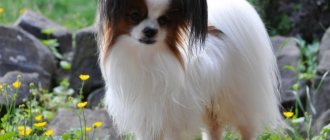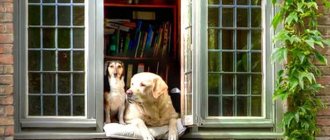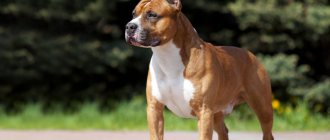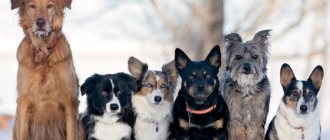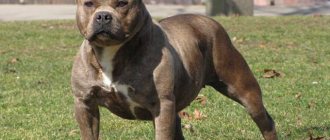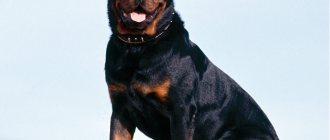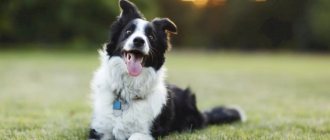When we buy a dog, we are buying not just a pet, but a family member, a friend, everyone’s favorite. But at the same time we take on a huge responsibility, because... You will have to walk with her, play with her, and provide accommodation for her during the holidays.
In addition, the owners will have to forget about saving, because... visits to veterinarians, routine vaccinations, purchase of quality food, etc. are required.
Considering the fact that purebred dogs are not cheap, not everyone can afford to buy such a pet. There are 2 options here. Or give a home to a charming mongrel. Or choose an inexpensive pet.
We'll look at the top 10 cheapest dog breeds that are as good as those that cost thousands of dollars. Each has its own character, characteristics and, of course, price, but this will not prevent them from becoming a devoted friend.
Papillon, from 5,500 rub.
This is a small companion dog with graceful ears adorned with long hair. They are of an unusual shape, somewhat reminiscent of butterfly wings. Her height at the withers is from 20 to 28 cm, and she weighs no more than 5 kg.
The Papillon is one of the most intelligent breeds. Their character traits are friendliness and loyalty. They never seem to be in a bad mood. They can infect others with their optimism and eternal joy.
But if their owners treat them poorly, dogs may become depressed. They will not tolerate rude intonations and may even be offended by shouting.
This is an obedient pet that will not damage furniture if left alone at home. But it is still advisable not to do this. He must have a friend, at least a cat.
A pet will grow up to be friendly only with proper, early socialization. Otherwise, Papillons may show aggression and bite.
Suitable for lovers of active recreation. They are easy to care for, they are inquisitive, and they have a high ability to learn and train.
Papillons easily get along with children and other animals. Their significant disadvantages are jealousy and a predisposition to disease.
How is the price of puppies determined?
It is believed that breeders reduce the price of offspring due to sexual dimorphism. Bitches are more expensive, especially if they continue to have a successful generation for sale. To make a dog inexpensive, it is worth considering the following factors:
- number of children in the litter (the more there are, the cheaper);
- nursery rating, its reputation;
- lack of awards and regalia from the puppy’s parents;
- sales region.
In capital cities, the cost coefficient is artificially inflated for reasons of demand, in order to avoid dumping. A dog is a commodity. Breeders invest in it and make a profit. The “law of the market” works when demand gives rise to many offers. A larger metropolitan area has a more varied selection.
The value of a dog is influenced by art. Demonstration of certain qualities in popular cartoons and films automatically raises the breed's rating. An example is the almost unknown Akita Inu in Russia. As soon as the film with the participation of the “Japanese” was released, the market demand for a puppy automatically increased, and numerous nurseries appeared, vying with each other to offer the purchase of a difficult-to-raise pet.
Another factor is age. Grown-up or adult dogs are sold inexpensively. The older the puppy, the cheaper it will be. This is explained by the fact that unclaimed offspring need to be sold off quickly. The breeder's expenses for food and care increase many times over. An excellent option for those who want to save money is to adopt a dog “as an acquaintance.” The law of the “spine” still works in Russia when there are acquaintances. All you have to do is call them, recommend them and buy a puppy cheaper.
Toy terrier, from 5,500 rub.
It is also a small dog, whose height does not exceed 28 cm, and it weighs from 1.5 to 3 kg. An ideal option for those who do not have much free space in their home.
Their character features include mobility; they can frolic all day long. Take this into account when buying this pet, because... with him you will have to forget about peace and solitude. They require constant attention, but in return they will give affection.
If you do not give him the opportunity to splash out his energy, aggressiveness may appear, and the toy terrier will begin to spoil things. Very smart dogs that can very cleverly manipulate their owners. They are not aggressive at all, but can act as a watchman, warning of the arrival of strangers with loud barks.
A feature of the breed is considered to be psycho-emotional instability. They can get worked up by any rustle, and it won’t be easy to calm the toy terrier down. Her bark is long and loud.
Another feature is the ability to remember; a pet can recognize a person whom it has seen only once.
Comparison of prices for different breeds of dogs
An inexpensive dog, especially if it is a popular breed, is sold at a price of 100 USD. If you take dogs from any category, then prices depend on the class of the breed, the number of puppies in the litter, and gender characteristics.
The cheapest ones are those that have a lot of representatives. The fewer individuals there are in the city or country where you live, the more expensive the pet will be. For example, the once “fashionable” breed of toy terrier just a few years ago cost an average of 500 USD. Now the price has dropped sharply due to falling demand.
The older the puppy, the cheaper it sells. The age factor influences pricing policy significantly. They offer to adopt an adult dog for free or under special conditions.
Small dogs are always interesting for dog handlers. Often them. Thus, the French Papillon was once only brought to the Russian Federation. For a mature dog they asked for up to 1.5 thousand. At the moment, representatives are often given away for a symbolic price.
Large and medium dogs will cost on average from 200 USD. If we take into account the creation of special conditions for maintenance and feeding, then their value is actually higher and the costs are higher. Therefore, there are many inexpensive dogs; it is important to decide on the breed and its characteristics.
French bulldog, from 5,000 rub.
The height of this dog is up to 35 cm, it weighs from 8 to 14 kg. These are the best companion dogs because... They are distinguished by their kind character and patience, complaisance, and friendliness.
He loves to go for walks, but in moderation, he will happily stay at home. There is no particular noise from it, because... The French bulldog rarely barks. Can become a true friend, because... devoted to both the owner and all family members.
Children quickly become attached to him, he never offends them. It is undemanding, but does not tolerate heat well (they need air conditioning). Disadvantages: tendency to flatulence, constant drooling and fur.
This is a decorative dog, but among its ancestors there were fighting dogs. Therefore, if a threat arises, they are ready to rush into battle and will fight to the end. You should avoid such encounters while walking.
Labrador retriever, from 5,000 rub.
Quite large animals: males grow up to 56-61 cm, weigh up to 34 kg, and females - from 53 to 58 kg, weigh 25-32 kg. If you don't like walking, choose another breed, because... Labrador Retrievers require long daily walks.
It is not intended to protect the house, but will accompany the owner on the hunt. Dogs love to eat, so you have to watch their weight.
But they are perfectly trainable and get along with other children and animals. They have a very easy-going and easy-going character; the Labrador Retriever is friendly and always tries to please people.
These dogs make the best guides and helpers for people with disabilities.
Pug, from 3,500 rub.
A small dog grows up to 28-32 cm, weighs from 6 to 8 kg. This is a completely non-aggressive breed, ready to be friends with everyone, both family members and strangers. They are very funny and sociable, adapting to the lifestyle of their owner.
A pug can live without long walks. An excellent option for a novice dog breeder. But they are very attached to people. If you leave your pug alone for a long time, he will become very stressed.
They are calm and balanced and will not bother you with barking. But they can sniffle or wheeze loudly and suffer from flatulence. They are also canine snoring champions.
Health and Diseases of American Hairless Terriers
American Hairless Terriers are classic healthy dogs that have avoided the genetic ailments of their ancestors and, with good care, live up to 12-15 years. However, some exceptions are possible. For example, in some individuals hereditary deafness can make itself felt, which can be identified by tests in veterinary clinics. Hypothyroidism and Perthes disease are also inherited by a small percentage of puppies.
A fairly common disease in American Hairless Terriers is patella luxation (luxation of the kneecap), which causes the dog to lame. If you notice that your pet has begun to hobble unnaturally, immediately have it examined by a veterinarian. We will also have to take into account the breed’s predisposition to demodicosis. The skin of American Hairless Terriers, unprotected by the undercoat, is especially susceptible to this unpleasant disease, which manifests itself in the form of peeling and abscesses.
Basset hound, from 3,500 rub.
The height of this dog is 33-38 cm, it weighs from 18 to 29 kg. The Basset Hound is a loyal, but rather stubborn pet. A dog's appearance is deceiving. She appears to be a quiet and modest person, but is actually cheerful and outgoing.
The Basset Hound is a true hound. If a dog attacks the trail of an animal, it will be almost impossible to distract it. Representatives of this breed have a sonorous and deep voice, which your neighbors will be able to verify if you leave him alone in the apartment. You need to constantly walk with him.
But they are distinguished by their extraordinary intelligence. If he is scolded, he is able to develop and implement a plan for revenge. The Basset Hound is not aggressive and tolerates the proximity of other animals.
The downside is that there is a lot of saliva. They are sloppy and splash water when they drink. And they will never give up their favorite habits; the owners themselves have to adapt to them. They love to sleep on sofas and beds.
York, from 3,000 rub.
The Yorkshire Terrier , or York , is one of the most popular decorative dogs in the world. The height of representatives of this breed is only 15-17 cm, and they weigh from 2 to 3.2 kg.
It is great for families with children, because... his irrepressible energy makes him an excellent companion for fun. York is ready to be friends with all family members, but he will choose one as the owner and will be devoted to him.
This breed is very hardy, energetic, with good reactions, despite its size, and is particularly courageous. They are very smart and easy to train.
The disadvantages are that they are picky about food, and some foods are contraindicated for them. We will have to constantly take care of his health and protect him from injury.
History of the American Hairless Terrier breed
American Hairless Terrier puppy
The American Hairless Terrier is a product of a genetic mutation that was released in the 80s of the last century. Hairless puppies were born into terrier families before, but until the second half of the 20th century, no one thought of breeding them. The pioneer in this area was a resident of Louisiana, Edwin Scott. Having purchased a hairless puppy from a pair of rat terriers in 1972, he became interested in breeding and began experimenting with inbreeding.
Scott christened the acquired bitch Josephine and began to wait for the animal to be ready for mating. Subsequently, the dog breeder several times bred his four-legged favorite with the rat terrier, who was her father, but most of the litters brought by the dog had normal hair. The long-awaited naked baby was born only once and immediately received the nickname Gypsy.
Eight years after her first mating, Josephine finally produced four puppies, two of which inherited their mother's hairless body. The babies were named Jemima and Snoopy, raised and used for breeding, just like their parent. Scott himself had by this time opened and registered a small kennel, in which he continued to experiment with the phenotype of hairless dogs.
The path to recognition for AGT was not swift. Only in 1998 the animals were registered by the American Rare Breeds Association. A year later, the UKC (United Kennel Club) joined the process. True, “nubs” were included in his lists at first not as an independent breed, but as a separate variety of rat terriers.
In 2010, the descendants of Edwin Scott’s wards received full recognition from the RKF, and in 2016 they were able to “break through” into the AKC breeding bases. Only the FCI commission does not give up its position, by decision of which American Hairless Terriers continue to be included in the organization with limited rights as a pre-approved breed.
Video: American Hairless Terrier
Border collie, from RUR 3,000
She is considered one of the smartest dogs in the world. They are often used for search and rescue work and make the best guide dogs. The height of males is 50-53 cm, and that of females is slightly less - 47-52 cm.
Those who live in a cramped apartment should not get this dog; they need space. The aviary is also not for them, because... they love freedom very much. They can get along with other animals, but only as a patron.
A passive lifestyle is not suitable for them; border collies need physical activity, any activity that requires energy. Their ancestors were shepherds, so they will gladly herd any living creature; they are incredible hard workers. It will not be possible to make a calm, “sofa” dog out of him. They are good-natured, with a peaceful character.
The smallest dog in the world
The record holder among miniature dogs was a Chihuahua named Millie. The baby weighs only 170 g with a height of 6.53 cm.
Thanks to these parameters, she was included in the pages of the Guinness Book of Records.
The smallest Chihuahua lives with a couple in Puerto Rico.
Pekingese, from 1,500 rub.
Small dogs ranging from 15 to 25 cm in height. The Pekingese is proud, a little capricious, and does not like fuss and noise. Suitable for older couples because... he likes a peaceful, calm environment.
They do not suffer from loneliness so much; they can be alone in the apartment. The Pekingese senses the owner’s mood and tries to moderate the communication. You should not take him into a family with children, because... he is indifferent to games and does not like to obey.
They do not like close physical contact and may bite. The Pekingese can make friends with cats, but cannot tolerate other dogs, especially large ones. Passive, do not require daily walks.
Dachshund, from 1,500 rub.
Its height at the withers is up to 35 cm, and it weighs no more than 12 kg. The dachshund is active, agile, independent, and at the same time smart.
She is tireless. Suitable for people who have time to communicate with their pet, because... a dachshund cannot live without the attention of its owner. She loves children. This is a dog with a strong character, fearless, and self-confident.
She will not forgive rough treatment of herself, she may become disobedient and do everything out of spite. Dachshunds should not stand on their hind legs or jump from heights due to the structure of their body.
69 22
American Hairless Terrier breed standard
American Hairless Terriers owe their extravagant appearance to their wide range of colors, which, combined with their hairless skin, turns them into compact living miracles. Individuals in spotted “clothes” look especially elegant, in which the colored marks on the body have a clear outline, enhancing the contrast of the color. By the way, AGT is one of the few breeds for whose representatives such large growth limits are established - from 25 to 46 cm.
In profile, the faces of American Hairless Terriers subtly resemble the heads of Pharaoh Hounds, but in a slightly less elegant design. A slight resemblance to the Maltese greyhound is also provided by the ears - triangular, standing vertically or half-dangling. Like all representatives of the terrier family, AGTs are very active, playful and jumping pets, so you can truly feel the charm of the breed only by watching its representatives in motion.
Head
The dog's skull is characterized by sufficient width, dome-shaped outlines and convex cheek areas. The muzzle has classic lines, tending to taper at the nose. All together this forms a wedge-shaped head with a smooth stop.
Teeth and jaws
The American Hairless Terrier's flexible jaws provide a strong grip. The teeth are of normal size, standing straight and meeting in a scissor or level bite (the first option is preferable).
Nose and lips
The nose must be uniform black or any other color in accordance with the color. The lips are closely attached to the gums, the color matches the color of the lobes.
Eyes
The bulging eyes of American Hairless Terriers resemble a circle rather than an oval in outline. The eyes are set obliquely, the eyelids are pigmented, the color matching the tone of the earlobes and lips. Any iris color is allowed, ranging from amber to dark brown. Allowed variations: blue, dark gray, as well as amber eyes for AGT of blue color.
Ears
The Terrier's V-shaped ear can be erect, semi-dropping, or raised on cartilage. The exception is individuals under the age of one year, whose ear position is unstable and may change as they grow older. At exhibitions, such dogs are not deducted for the appearance of their ears.
Neck
Graceful, smooth, muscular, with a beautiful curve. At the head, the girth of the neck is slightly narrower than at the base.
Frame
The purebred AGT has a slightly elongated body. An animal that is moving and frozen in a stance always has a straight back. The lumbar region is moderately short and prominent. A slight bevel is typical for the croup; the belly is normally tucked. The chest has sufficient depth and width, in its lower part it descends to the level of the elbows or lower.
Limbs
When standing, the dog's forelimbs look perfectly straight and strong. The shoulder area is filled with dense muscle tissue. The shoulder blades are characterized by a backward deviation and a close fit to the withers at the top. The forearms form a 90° connection angle with the shoulder blades. Short powerful pasterns stand almost vertically.
Hind legs in balance with the body, with shins and thighs of equal length. The articulation angles are clearly marked. In the stance, short metatarsals are characterized by being set parallel to each other, forming a vertical line. The animal's miniature paws resemble an oval in outline. An important feature is that the middle toes on the paws grow longer, but they should not be too flattened or turn out to the sides. It is also necessary to remove dewclaws on the hind legs (on the front legs - at the initiative of the owner).
Tail
The tail of the American Hairless Terrier is thick at the base, with a moderately thin tip. In an alert dog, he assumes a saber-like position. A relaxed animal holds its tail below its back or slightly higher. In representatives of the breed with fur, the tail is allowed to be docked, but only between the second and third vertebrae from the base.
Wool
AGT litters still produce hairy puppies. It is easy to distinguish such babies: their bodies are covered with smooth short hair through which the skin does not show through. Completely “bald” individuals are born dressed in airy downy “coats” that disappear at 6-8 weeks of life. In adult "naked ones" the eyebrows, chin and sideburns are covered with a small amount of hair. Sometimes very sparse thin hairs may grow on the body, which is considered normal. An important feature: in uncomfortable situations, the dog may sweat, then droplets of moisture appear on the body and hairs.
Color
For completely hairless terriers, the same color types are allowed as for the "wool" variety. Often naked individuals have spotted skin that changes color when exposed to sunlight. In addition, with age, the area of spots on the body increases. Sometimes single-colored “bald heads” may appear, which have a unique charm.
Common colors of individuals whose bodies are covered with hair are two-color, three-color, solid white, motley, red with darkened ends (sable). A mandatory requirement for all of the listed colors, except solid white, is the presence of white zones of all sizes located on any part of the body. Less popular but acceptable breed colors: brown, black, apricot, blue, lemon. The listed colors can be of varying degrees of intensity, but it is imperative that the lobes and edging of the animal’s eyes be colored to match the coat.
Disqualifying defects of the breed
The main defects of exterior and behavior, the presence of which threatens American Hairless Terriers with inadmissibility to the exhibition ring:
- marbled wool;
- complete absence of white areas on the body, as well as any solid color other than white (only for dogs with fur);
- aggression and lack of self-confidence in the ring;
- deafness – complete or one-sided;
- albinism;
- curly hair;
- short-legged – when the animal does not fit into the ratio of 10:9 in terms of length and height;
- hanging ears;
- congenital bobtail;
- cryptorchidism in any form.

